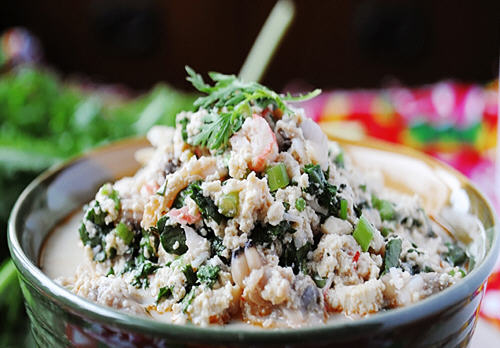
Okara(soy pulp, or tofu dregs) is a pulp consisting of insoluble parts of the soybean that remains after pureed soybeans are filtered in the production of soy milk and tofu. It is generally white or yellowish in color. It is part of the traditional cuisines of Japan, Korea, and China. Since the 20th century, it has been used in the vegetarian cuisines of Western nations.
Production
Okara is a food by-product from tofu and soy milk production. In 1983 it was estimated that the annual yield for okara in Japan was approximately 70,000 metric tons.
Due to its high moisture and nutrient content, okara is highly prone to putrefaction, and this has limited its commercial use.
Composition
Okara that is firmly packed consists of 3.5 to 4.0% protein, 76 to 80% moisture and 20 to 24% of solids. When moisture free, the gritty okara contains 8 to 15% fats, 12 to 14.5% crude fiber and 24% protein, and contains 17% of the protein from the source soybeans. It also contains potassium, calcium, niacin. Most of the soybean isoflavones are left in okara, as well as vitamin B and the fat-soluble nutritional factors, which include soy lecithin, linoleic acid, linolenic acid, phytosterols, tocopherol, and vitamin D.
Okara contains some antinutritional factors: trypsin inhibitors (mostly destroyed by cooking), saponins, and soybean agglutinins, which cannot be easily digested.
Fermentation (by proper species of bacteria) of okara is conducive to digestion and absorption of okara nutrients, and it further improves the nutritional value. It can eliminate the bean’s odor, increase the amount of edible fiber, free amino acids, sugars, fatty acids, vitamin B12, vitamin B2, and flavoprotein.
Human consumption
Okara is eaten in the Shandong cuisine of eastern China by steaming a wet mixture of okara that has been formed into blocks of zha doufu (also known as xiao doufu or cai doufu).